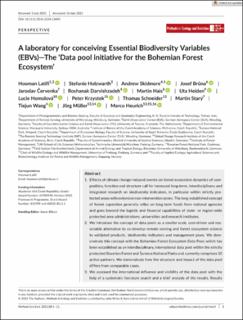A laboratory for conceiving Essential Biodiversity Variables (EBVs)—The ‘Data pool initiative for the Bohemian Forest Ecosystem’
Müller, Jörg; Wang, Tiejun; Starý, Martin; Schneider, Thomas; Krzystek, Peter; Homolová, Lucie; Heiden, Uta; Hais, Martin; Darvishzadeh, Roshanak; Červenka, Jaroslav; Brůna, Josef; Skidmore, Andrew; Holzwarth, Stefanie; Latifi, Hoolman; Heurich, Marco
Peer reviewed, Journal article
Published version
Permanent lenke
https://hdl.handle.net/11250/2999250Utgivelsesdato
2021Metadata
Vis full innførselSamlinger
Originalversjon
https://doi.org/10.1111/2041-210X.13695Sammendrag
Effects of climate change-induced events on forest ecosystem dynamics of composition, function and structure call for increased long-term, interdisciplinary and integrated research on biodiversity indicators, in particular within strictly protected areas with extensive non-intervention zones. The long-established concept of forest supersites generally relies on long-term funds from national agencies and goes beyond the logistic and financial capabilities of state-or region-wide protected area administrations, universities and research institutes. We introduce the concept of data pools as a smaller-scale, user-driven and reasonable alternative to co-develop remote sensing and forest ecosystem science to validated products, biodiversity indicators and management plans. We demonstrate this concept with the Bohemian Forest Ecosystem Data Pool, which has been established as an interdisciplinary, international data pool within the strictly protected Bavarian Forest and Šumava National Parks and currently comprises 10 active partners. We demonstrate how the structure and impact of the data pool differs from comparable cases. We assessed the international influence and visibility of the data pool with the help of a systematic literature search and a brief analysis of the results. Results primarily suggest an increase in the impact and visibility of published material during the life span of the data pool, with highest visibilities achieved by research conducted on leaf traits, vegetation phenology and 3D-based forest inventory. We conclude that the data pool results in an efficient contribution to the concept of global biodiversity observatory by evolving towards a training platform, functioning as a pool of data and algorithms, directly communicating with management for implementation and providing test fields for feasibility studies on earth observation missions.

